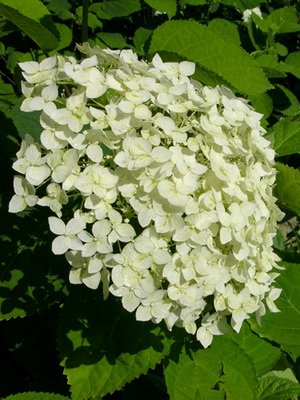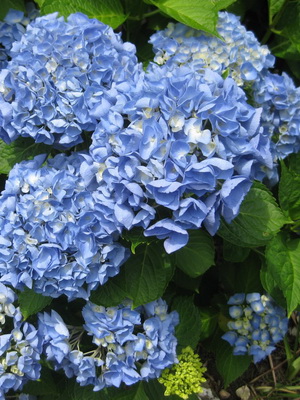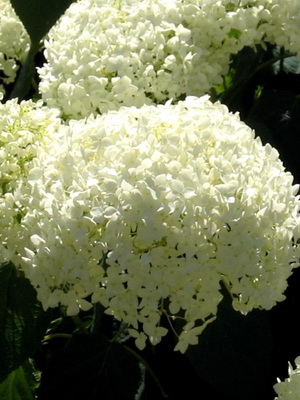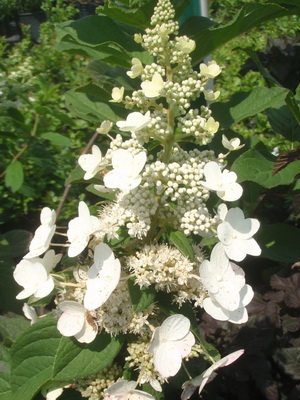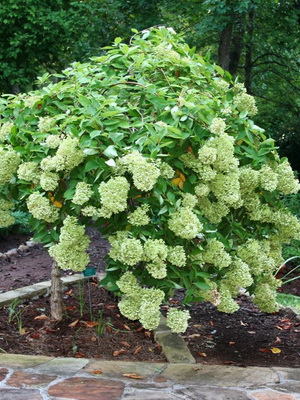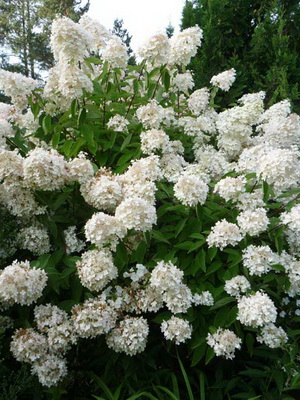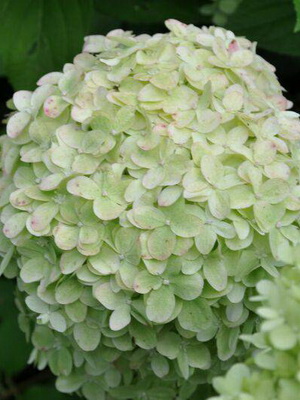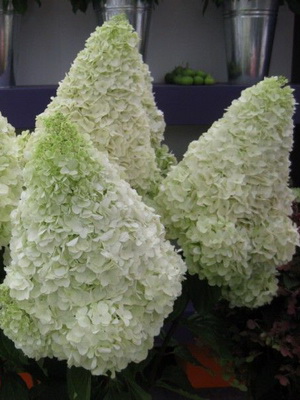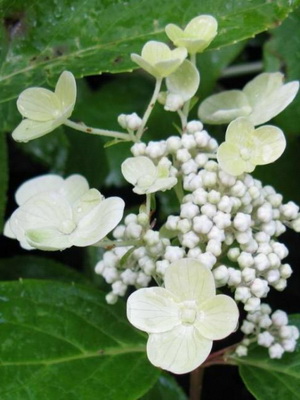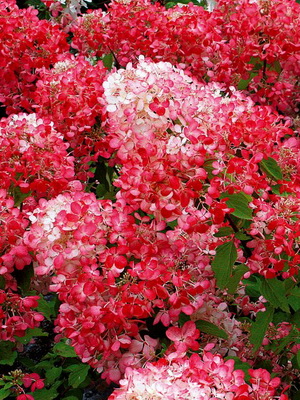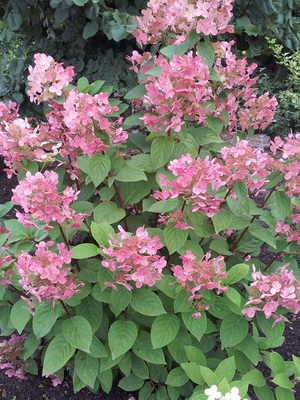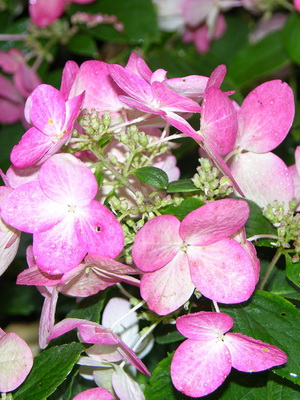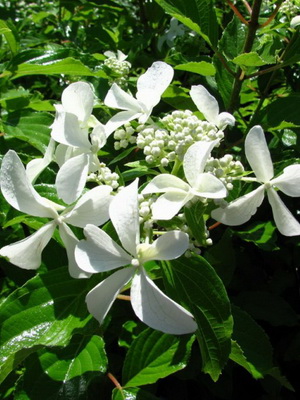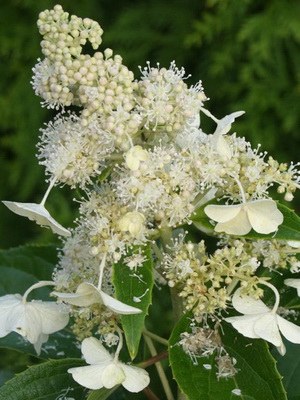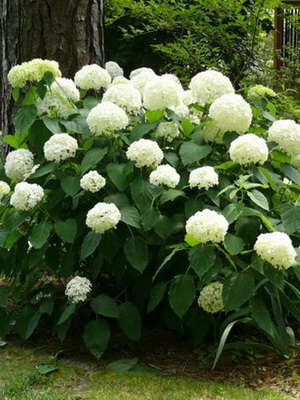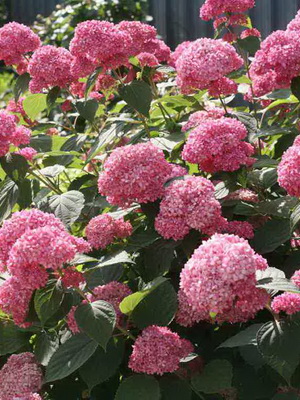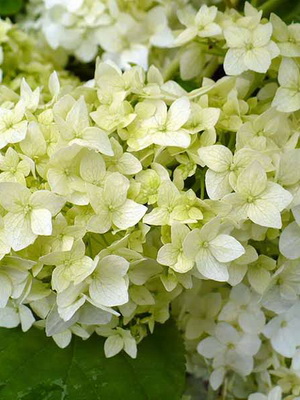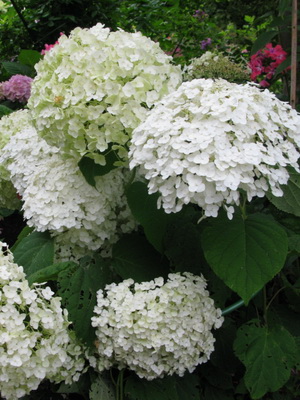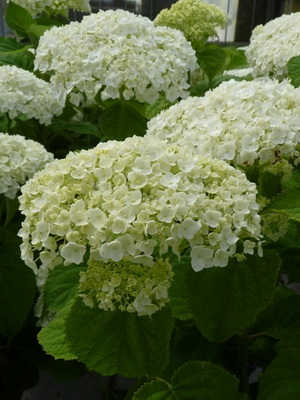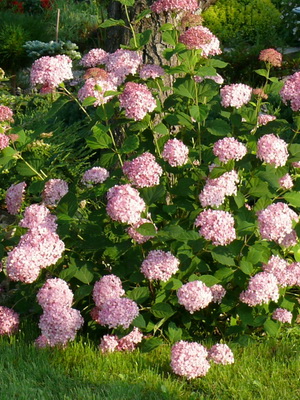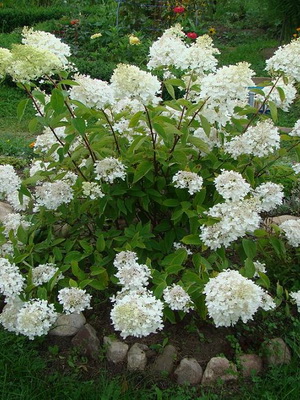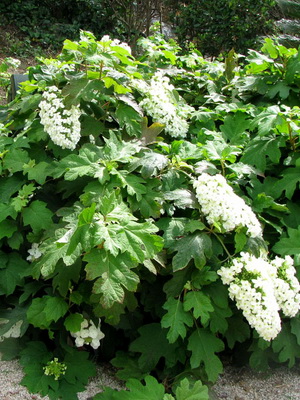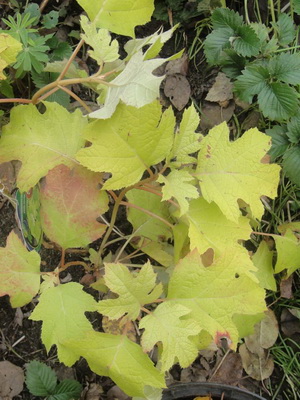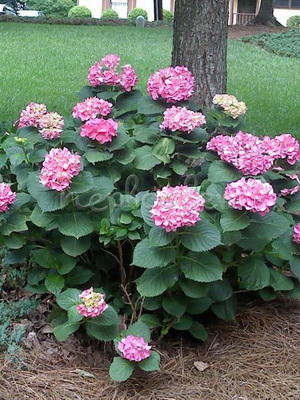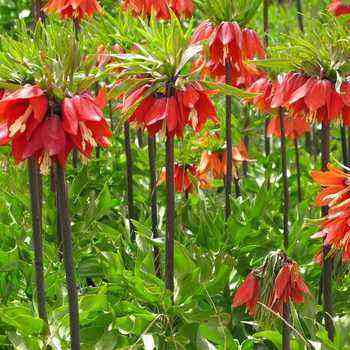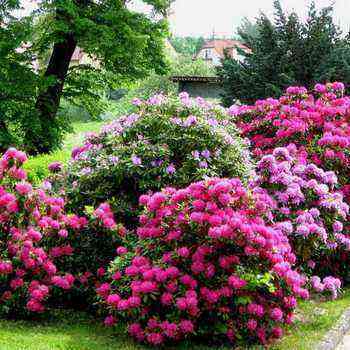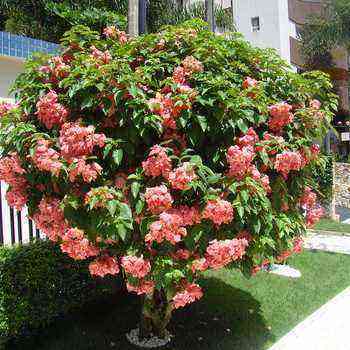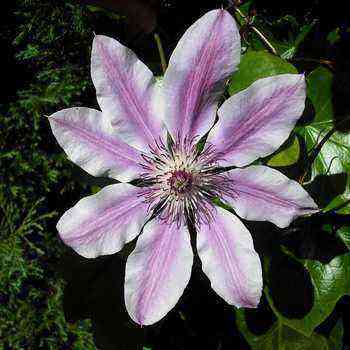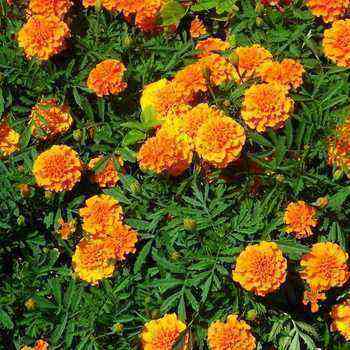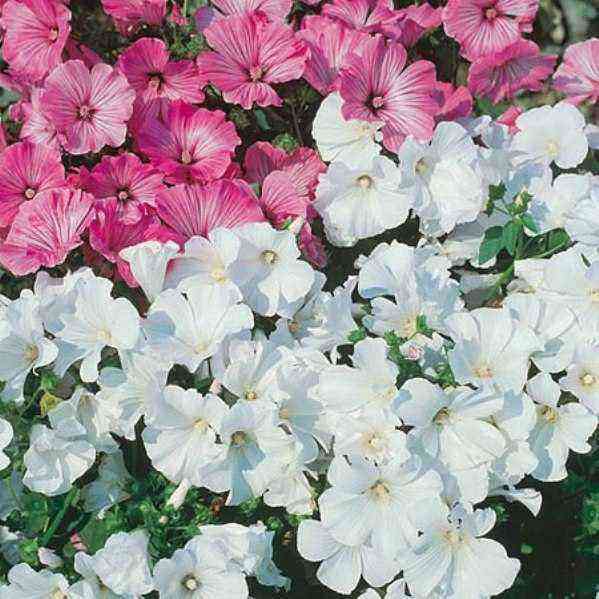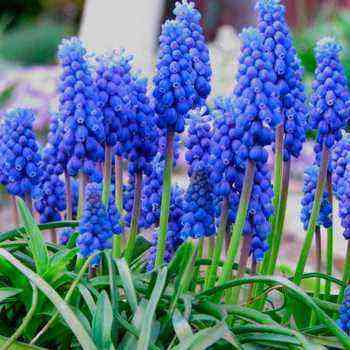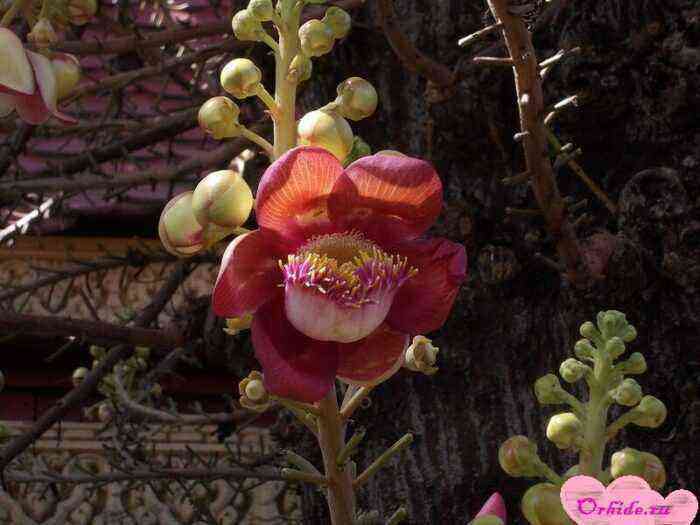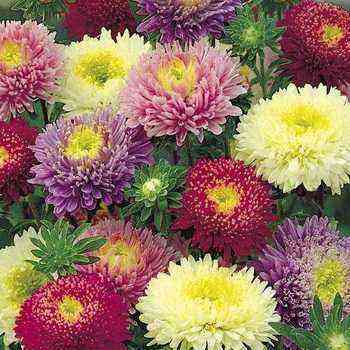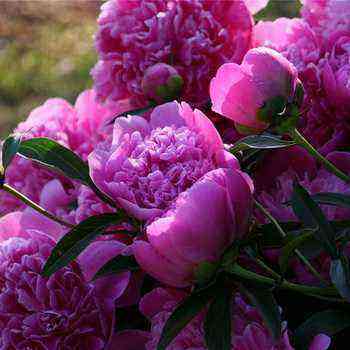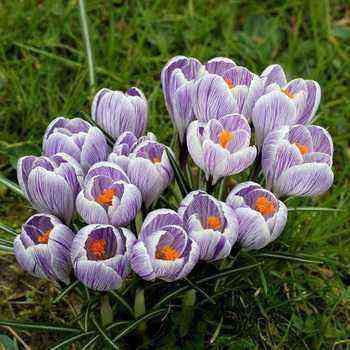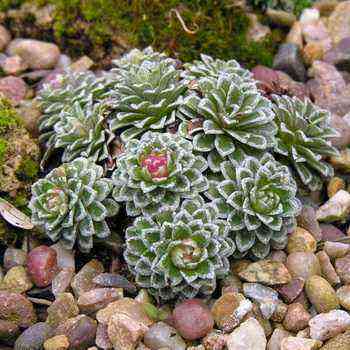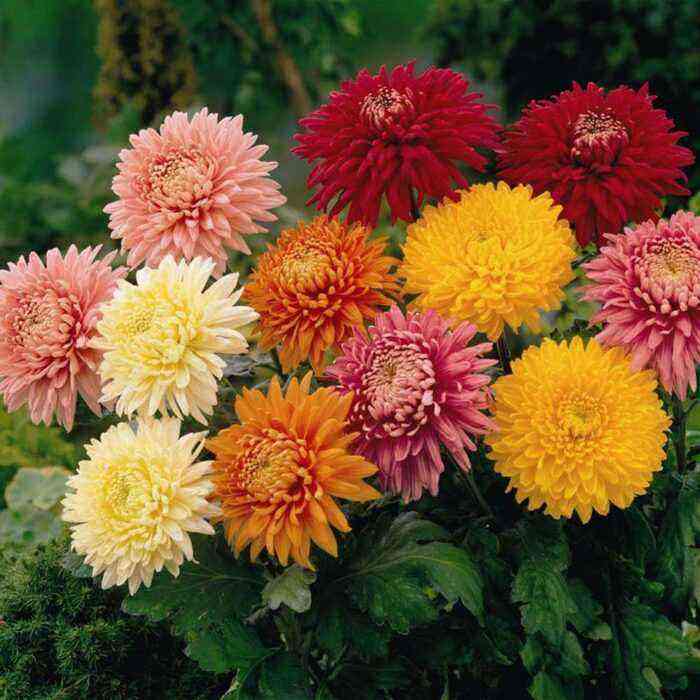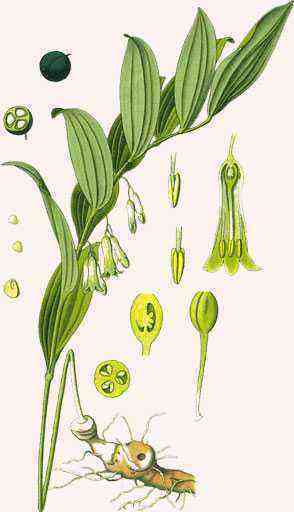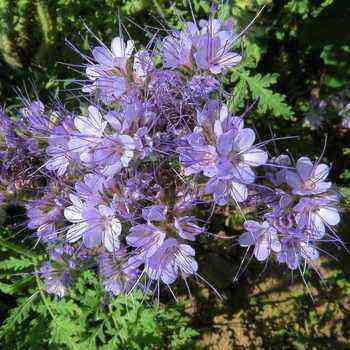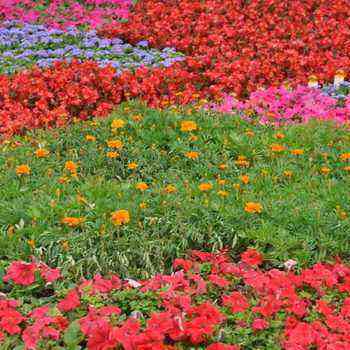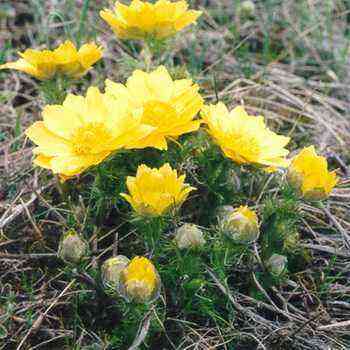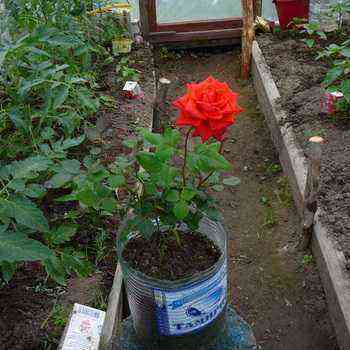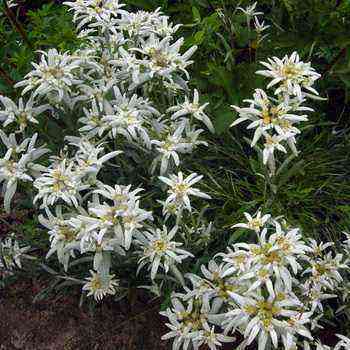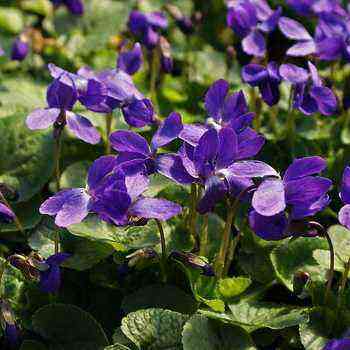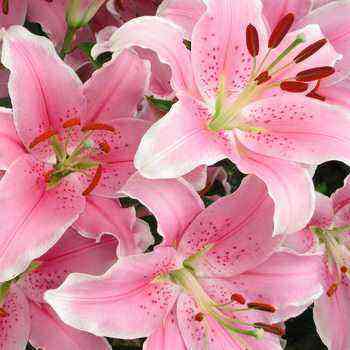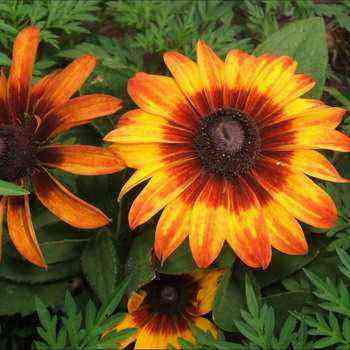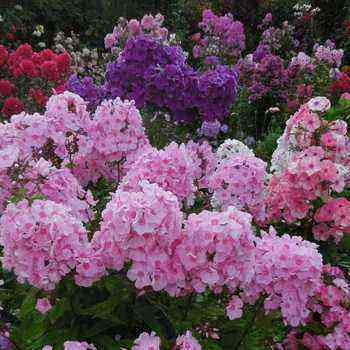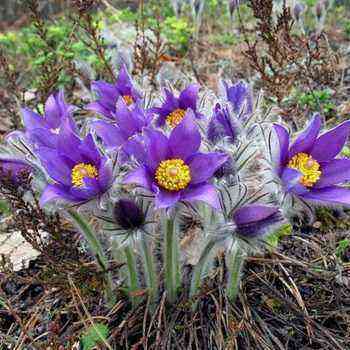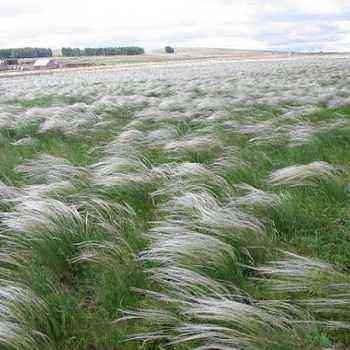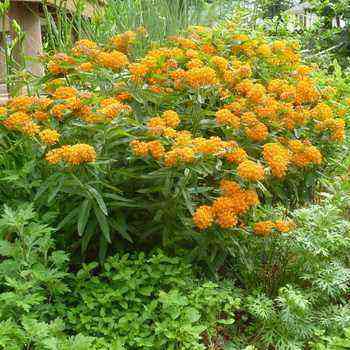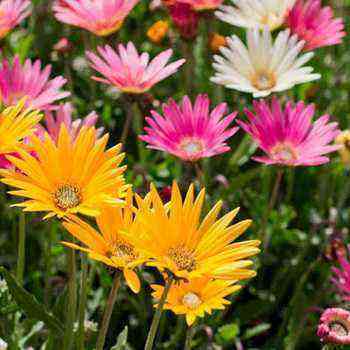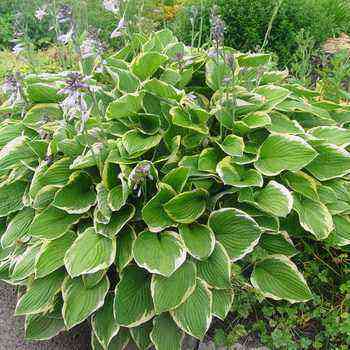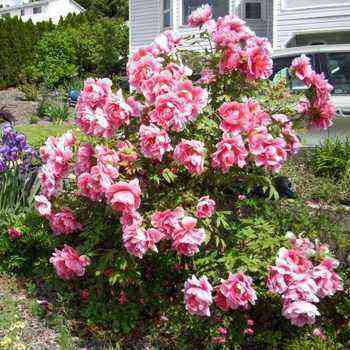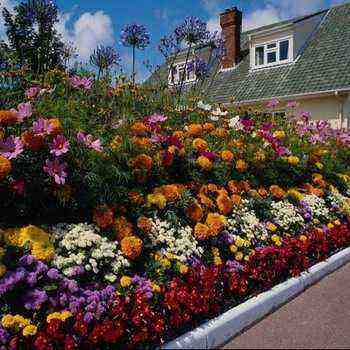
In this article, we will take a short excursion into the past in order to acquaint you with the history of the hydrangea flower, tell you about the types and varieties of hydrangeas, give some recommendations on planting and caring for a garden hydrangea, and, of course, provide an opportunity to enjoy the flowers of a garden hydrangea on Photo.
Hydrangea flowers in the garden
The nature of central Russia is not rich in flowering shrubs. This gap is filled with winter-hardy plants introduced from other places. Some of them (like lilacs, wrinkled roses) are so fond of and widespread in Russian gardens that one gets the feeling that they are our “native” plants. Others are undeservedly ignored and are still quite rare guests in the gardens. These include the flowers of the garden hydrangea, although it is difficult to find a shrub that would differ in such a duration of flowering in the second half of summer.
In addition, among the garden hydrangeas there are species that perfectly tolerate a temperate climate and are distinguished by their unpretentiousness in culture. Therefore, it is difficult to explain our “disfavor”. But the active selection of this culture, which gives us more and more diverse varieties, contributes to the fact that various types and varieties of hydrangeas in the gardens of the middle lane appear more and more often.
Garden hydrangea flowers: historical background
The Europeans got acquainted with the hydrangea at the end of the 18th century, when the participants of the first French round-the-world expedition brought the large-leaved hydrangea from the island of Mauritius in the Indian Ocean. It got its name in honor of the beautiful princess Hortense, sister of Prince K.G. Nassau-Siegen, a member of the expedition. There is also a more romantic version that she was named by the French physician and naturalist F. Commerson in honor of the charming lover Hortense. However, there is also a completely prosaic explanation that the name comes from the Latin word hortensis, which means “from the garden”, since the shrub was found in the garden of the governor of the island of Mauritius.
Later, botanists, referring the hydrangea to the genus Hydrangea, gave it the name Hydrangia, however, the old name was preserved in another name for this species – hydrangea. The plant received a new name for its moisture-loving nature. In Greek hydor is “water”, angeion is “vessel”, which gave Hydrangea.
Some authors associate the appearance of the word “vessel” in the title with the fact that the seed pods of the plant resemble a jug, others with the need to always have a vessel with water for abundant watering.
Types and varieties of hydrangeas in the photo
The genus of hydrangeas contains several dozen species (botanists still have no consensus on the number of species) and belongs to the family of the same name Hydrangeaceae.
Most species are shrubs with large leaves, less often they are small trees or vines.
As you can see in the photo, all types of hydrangea have flowers collected in large corymbose or paniculate inflorescences and are usually located at the ends of the shoots.
In most types of hydrangeas, the inflorescences contain two types of flowers: small, fertile (fertile) flowers and large sterile (sterile) flowers, which are usually located at the edge of the inflorescences. Most species are white or pink in color.
Description of hydrangea paniculata and its photo
For gardening in central Russia, panicle and tree hydrangeas are of greatest interest. These hydrangeas are most often found in older gardens.
In recent years, the selection of panicle hydrangea (H. paniculata) has been quite active, and almost every year new varieties appear on the market. In the gardens of the Moscow region, its growth does not exceed 3-3.5 m. The description of the panicle hydrangea is similar to the description of the tree hydrangea, the main difference is in the shape of the inflorescences.
Wide-pyramidal paniculate inflorescences of hydrangea up to 20-25 cm long consist of small fertile flowers and large sterile ones.
Look above at the photo of panicle hydrangea – the color of the petals is white at first, then they turn pink, and by the end of flowering, greenish tones appear in their range. This sign of color change is more or less characteristic of all varieties. Large elliptical or ovoid leaves, slightly pubescent above and noticeably stronger below.
The species and varieties are distinguished by very long flowering. Early varieties bloom in June, most bloom in July.
But the most late-flowering hydrangea variety “Tardiva” (“Tardiva”) should not be started, because it blooms in October, and simply does not have time to prove itself. It is worth noting that often under this name the variety “Floribunda”, which is very widespread in the West, is on sale.
Hydrangea paniculata “Grandiflora”
Most often, the old hydrangea variety “Gmndiflom” (“Grandiflora”), or, as it is also called in the West, “Pee Gee” (from the abbreviation of the name Paniculata Grandiflora) is grown in the gardens. Hydrangea paniculata “Grandiflora” has large, dense inflorescences, consisting of sterile flowers.
Hydrangea paniculata “Limelight”
Hydrangea “Limelight” – the first variety with dense inflorescences of sterile flowers with a distinct greenish tint, turning pink by the end of the season.
Hydrangea paniculate “Limelight” reaches a height of 1.6-2 m. A small copy – “Little Lime” (“Little Lime”) up to 1 m high.
Hydrangea paniculata “Pinky Vinky”
Hydrangea “Pinky Winky”, syn. “DVPinky” (“Pinky-Winky”) , has conical openwork inflorescences with a large number of sterile flowers that acquire a purple-pink color. Hydrangea paniculata “Pinky Vinki” reaches a height of 1.5-1.8 m.
Hydrangea paniculata “Phantom”
Hydrangea «Phantom” ( «phantom”) – a large shrub up to 2.5 m and spreading crown very large pyramidal creamy white inflorescences. By autumn, the inflorescences of hydrangea paniculata “Phantom” evenly turn pink.
Hydrangea paniculata “Vanilla freise”
Variety “Vanille Fraise” (“Vanilla Fraise”) has a very dense large conical inflorescence, quickly acquiring a pleasant strawberry-pink color. A real vanilla strawberry dessert. The bush is up to 2 m high. A reduced copy of the Vanilla Fraise panicle hydrangea variety is the Sundae Fraise variety, reaching a height of 1-1.2 meters.
Varieties of hydrangea paniculata
Now the market offers a large number of varieties of panicle hydrangea, differing in the density and color of the inflorescences, the height of the bushes, and the flowering period.
«Dharuma» ( «Daruma») is probably the most undersized grade. Small creamy openwork spherical-flattened inflorescences turn dark pink over time. The leaves also take on a reddish tone, complementing the red color of the shoots.
Hortensia «the Diamant Rouge” (Daymont Rouge “) has large dense buds and very quickly appears juicy red. The plant is 1.5-1.8 m high.
Variety “Early Sensation”, syn. “Bulk” (“Earle Sensation”) , blooms very early, wide-cone-shaped openwork inflorescences. Fertile flowers quickly turn purple-pink, harmoniously complementing the dark purple shoots. By the fall, the leaves also take on a purple hue.
Great Star, syn. “Le Vasterival” (“Great Star”) – a variety with very large white sterile flowers with elongated petals in the form of a “propeller”, hovering above the bulk of small fertile flowers. The height of the bush is up to 2 m.
“Kiyushu” (“Kiushu”) is an old variety up to 2.5 m high, characterized by erect shoots and delicate inflorescences. It was not necessary to catch the described smell.
Hortensia «White Lady” ( «White Lady”) . Long openwork inflorescences adorn a few large flowers with jagged edges of the petals. The flowers retain their white color for a long time. The height of the bush is up to 2 m.
The variety “Wim” s Red “ (” Wims Red “) has a beautifully shaped bush up to 2 m high with large openwork inflorescences covering it from the top to the ground. Blooms in June with white flowers, which then become deep pink and, finally, burgundy red.
Hydrangea tree and her photo
Another beauty, firmly enduring our climate, H. arborescens. This is a short shrub up to 1.5 m high with a neat rounded crown and slightly pubescent shoots. Hydrangea leaves are tree-like, large, ovoid or elliptical, serrated along the edge, with a heart-shaped notch at the base. The leaf is green above, bluish below.
As you can see in the photo, the hydrangea treelike has a corymbose inflorescence, consisting of small white fertile flowers and relatively large sterile ones. Blooms for a long time from the first half of July. In very harsh winters, it can freeze slightly.
Treelike hydrangea varieties: photos and descriptions
As in the case of Paniculata, in the gardens usually there is not a natural species, but a variety of hydrangea tree-like “Annabelle”, blooming with large (up to 25 cm in diameter) inflorescences of white sterile flowers.
Much less common forms of this hydrangea “Gmndiflom” (“Grandiflora”) and “Sterilis” (“Sterilis”) with similar dense hemispherical inflorescences of sterile flowers.
Hayes Starburst, syn. “Double Annabelle” (“Hayes Starburst”) – the first variety of hydrangea tree-like with double flowers filling rounded inflorescences up to 25 cm in diameter. The flowers are greenish at first, then turn white. The bushes are not tall, thin shoots often do not withstand the severity of the inflorescences. The height of the bush is 0.8-1.2 m.
Incrediball, syn. Abetwo “ (” Incrediboll “) , – a variety that strikes the size of globular white inflorescences. The height of the bush is 1.2-1.5 m.
Sort “InvincibelleSpirit”, syn. “Invincibelle” (InvincibelleSpirit “) , conquers with large pure pink inflorescences of sterile flowers. Over time, the flowers fade to a light pink color. The bush is 0.9-1.2 m high.
Variety “White Dome”, syn. “Dardom” (“White House”) , is distinguished by large corymbose inflorescences with creamy white fertile middle and snow-white sterile marginal flowers. The plant is 1-1.4 m high.
In addition to these two species, other hydrangeas can find a place in our gardens.
First of all, this is the city of Bretschneider (N. bretschneideri). Some botanists do not distinguish it as a separate species, but consider it a variety of ground cover (H. heteromalla). It is not as decorative as the species described above, but it has high winter hardiness. Reaches a height of 2.5-3 m and forms a lush dense bush with a wide-rounded crown with large dark green leaves. It blooms profusely from the end of July with wide umbellate inflorescences, consisting of small fertile flowers, which are adorned with white large sterile flowers along the edge, acquiring a purple-pink color by the end of flowering. Thanks to the juicy beautiful foliage and delicate dull inflorescences, the shrub is good for creating a background and in informal living hedges.
Hydrangea leaves and their photos
Hydrangea attracts not only with flowers, but also with beautiful juicy foliage. At the same time, there are plants that have especially decorative leaves. In g. Radiant (N. radiate) – sometimes it is described as a type of tree hydrangea – large foliage, dark green above and white-tomentose-pubescent below. If the plant is planted in a windy place, then it will be possible to observe the “overflow” of foliage colors. Blossoms from July with corymbose inflorescences with numerous white marginal sterile flowers. Hardy enough, but the root system should be covered, and the shoots should be bent to the ground. Then, in the event of freezing of the shoots, the plant will quickly recover. The variety “Samantha” (“Samantha”) was bred with large leaves and a contrasting silvery reverse side.
Pay special attention to the photo of the leaves of the oak-leaved hydrangea (N. quercifolia). Unlike other species, its leaves are not whole, but lobed, resembling oak leaves, for which it received its specific name. In autumn, they take on a very beautiful red-purple color, adding to the charm of the bush. In addition, this species blooms with large beautiful paniculate inflorescences. Many decorative and flowering varieties of this hydrangea have been obtained, but it is not winter-hardy enough in our climate, and it is easier to get by with varieties of paniculata. But the species itself and especially varieties with decorative foliage can be used as decorative deciduous plants, growing them as perennials. In this case, it is enough to cover the root system before winter, and in the spring new shoots with beautiful foliage will grow.
The hydrangea variety “Burgundy” is distinguished by an especially bright purple autumn color of the leaves, while in “Little Honey” it attracts with golden yellow tones.
Stalked hydrangea and her photo
Having seen petiolate hydrangea, or g. Climbing (H. petiolaris = H. scandens) in the Baltic States, some gardeners try to grow it here too, forgetting that winters are milder in the Baltic States. In our climate, this species can be used either as a ground cover plant, or by removing it from supports before winter. Additional shelter will not hurt either, since in winters with little snow, shoots may suffer.
Look at the photo of petiolate hydrangea – this plant has large, corymbose, loose inflorescences, consisting of fertile flowers with marginal sterile flowers. A mass of aerial roots and suckers is formed on the shoots, with the help of which this hydrangea is able to climb up to 25 m in the south. Due to its large, heart-shaped, dark green leaves, when grown as a ground cover, it forms a dense green “blanket”.
Large-leaved hydrangea and her photo
Of course, the most beautiful and desirable is the large-leaved hydrangea, with which the story began. Unlike other ratenias, it strikes with a variety of colors, and not only in different colors: white, pink, red, purple, blue, violet, but also in their combinations.
As you can see in the photo of large-leaved hydrangea, this variety of colors is added to the variety of flower and inflorescence shapes.
However, its winter hardiness does not correspond to our frosts, and choosing a reliable shelter option is not an easy task. If the shoots are not covered well enough, then they will freeze, if they are covered tightly, but it will be wet, the shoots will trample. Covering too late or opening too early in spring will kill the flower buds. The most reliable option is when the hydrangea is grown in a greenhouse, then planted in open ground, transferred to the greenhouse in the fall, and removed to the basement for the winter.
In recent years, new “winter-hardy” varieties have appeared, distinguished by remontant flowering.
These are the popular Endless Summer series, abbr. ES (Endless Samme), and Forever & Ever, abbr. FE (Foreve Eve). Sellers made them “hibernating without shelter”, because flower buds do not withstand frost, and shoots often freeze out. The main difference from the old varieties is that they can bloom again on the shoots of the current year. But this is for the 7-8th climatic zone.
If you want to have flowering on the shoots of last year, then the bush must be covered for the winter, and everything that was described above remains true for these varieties. If you still managed to save the shoots, and your hydrangea bloomed, this does not mean that it will flourish a second time. In our zone, the season is shorter and the sum of positive temperatures is lower, so the plant may not have time to bloom a second time. For this to happen, it is necessary to create a greenhouse over the bush in the spring, so that the plant begins to vegetate earlier; cut off flowering shoots as early as possible; the bush should be planted in a sunny place and watered abundantly; carry out regular feeding and have a “warm” microclimate on your site. In this case, you may be able to achieve re-flowering.
Planting and caring for garden hydrangea
Plants are unpretentious, but it is better to choose open places or partial shade for planting garden hydrangeas (for colored varieties, a little shading is desirable at midday). The place should be well-drained, especially for insufficiently winter-hardy species.
When planting and caring for garden hydrangea, you do not have to worry about the special saturation of the soil with minerals, this plant is not demanding. However, it grows and blooms better on loose fertile moisture-absorbing soil with an acid reaction (pH about 5-6). Therefore, peat is necessarily introduced into the substrate.
Hydrangeas are calcephobes, which should be considered when choosing partner plants and using fertilizers. When the soil is alkalized or lime gets in, chlorosis develops in plants. As the name of the genus suggests, hydrangeas are demanding on soil moisture and prefer abundant watering, especially on hot sunny days.
When caring for garden hydrangea, the soil must be mulched to retain moisture. Planting is mulched before winter to cover the root system. To ensure the lush flowering of hydrangeas in the open field, regular feeding is necessary. In the spring, after pruning, nitrogen fertilizers are applied, later (in May-June) they are fed with a complex fertilizer that does not contain calcium and chlorine, phosphorus and potassium fertilizers are introduced into the budding phase, and at the end of August – potassium sulfate. It is good to use manure infusions with superphosphate as top dressing.
Growing hydrangeas requires pruning in the spring (April-May). The height of the bush can be adjusted to a certain extent by the degree of pruning. Without pruning, the bushes thicken, which is reflected in the abundance of flowering and the size of the inflorescences.
Insufficiently winter-hardy species need winter shelter. The most reliable is pot culture, when the plants are harvested in the greenhouse in the fall and then transferred to the basement.
Today, a sufficient number of varieties have been bred so that you can choose a plant for your garden. Hydrangeas are grown not only singly or in groups, but also together with other plants. Due to its late flowering, it is indispensable for creating flower beds that delight us at the end of the season.

